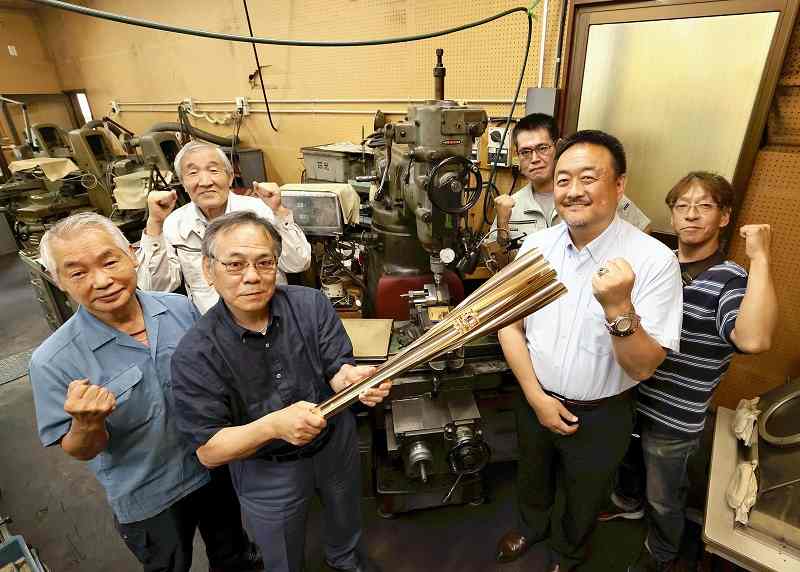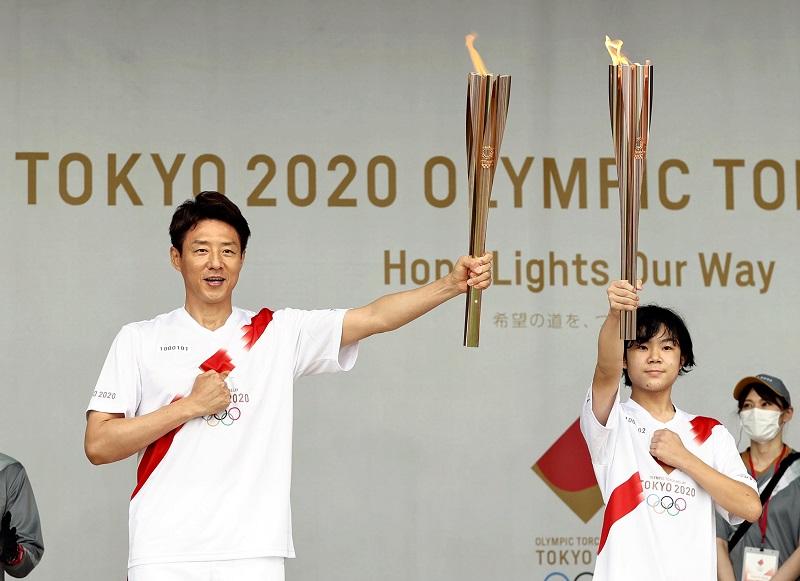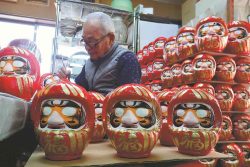
Norio Yamagishi, second from right, who led the team to develop a hydrogen-powered torch, and artisans of a factory that helped the team to produce a valve for hydrogen are seen in Adachi Ward, Tokyo, on July 6.
14:17 JST, July 16, 2022
For the first time in the history of the Olympics, clean-burning hydrogen has been harnessed to provide some of the flames for the Games’ torch relay.
The team involved in developing a hydrogen-powered torch for the relay included artisans from specialty businesses in Tokyo. Now they hope their creation will become a symbol of a new era by using an energy source that does not emit greenhouse gases.
On July 9, an orange flame shot up from the tip of a torch held high by former professional tennis player Shuzo Matsuoka during a ceremony in Machida, Tokyo. The torch was hailed as “the world’s first hydrogen-powered torch.”
“It is new and shows Japaneseness,” Matsuoka said. “It has provided an opportunity to showcase an environmentally friendly Olympics.”
Hydrogen is generally called the “ultimate clean energy,” because it does not emit carbon dioxide when burned and there is an inexhaustible supply on Earth. As Japan has been at the forefront of the development of related technologies, the Tokyo Organizing Committee of the Olympic and Paralympic Games decided to use the Tokyo Games to promote the potential use of such technologies.
About 10,000 torches are planned to be used in the torch relay traveling around Japan. The flame is usually created by burning gas, but 16 of these torches are powered with hydrogen. The development of such special torches began in the summer of 2018.
3 days before deadline
“It was only three days before the deadline that we had been able to meet the requirements set by the organizing committee,” said Norio Yamagishi, the 57-year-old leader of a team tasked with the development of a hydrogen-powered torch. He works for a major automobile company producing hydrogen-powered vehicles.
The design of the hydrogen torch was required to be the same as that of a gas-fired torch. The flame had to rise 20 to 30 centimeters above the tip of the torch and burn continuously for 20 minutes.
Yamagishi and his team members designed the torch, which has a special alloy inside, to release hydrogen when heated by a lithium-ion battery.
A major challenge was the torch’s weight, according to Yamagishi. An ordinary torch weighs about 1.2 kilograms, but the hydrogen version weighs more than twice as much. It was feared that the weight would make it difficult for torch relay runners to run while holding the torch with one hand.
With support from a metal-processing company that has been in business for about 60 years in Katsushika Ward, Tokyo, the team managed to reduce the weight by about 100 grams by subjecting the outer part of the torch body to chemical milling.

Shuzo Matsuoka, left, raises a hydrogen-powered Olympic torch during a ceremony in Machida, Tokyo, on July 9.
Delicate balance achieved
Because molecules of hydrogen are much smaller than those of gas, they leak easily. The development of a special valve for hydrogen was also a challenge. A factory that has made gas lighters and metal products in Adachi Ward, Tokyo, for about 70 years helped the team overcome the issue.
The factory has the technology to drill 60-micrometer holes in metal, but still it took a year to complete the valve. The valve used for the hydrogen is only 15 millimeters in diameter and has a complicated structure. Time was required because it was a formidable task to open three holes that control the flow of hydrogen in a balanced manner.
Tsuyoshi Meguro, 50, who was in charge of this project at the factory, said: “If the position of each hole is off by even 0.05 millimeter, the valve becomes useless. Our artisan skills and senses were put to the test.” Given that, Meguro said he was moved when the valve was completed.
Even after the torch relay began, the development team continued to make improvements. To achieve a better balance for the flame, the team extended the height of the flame about 5 centimeters by adjusting the eruptive volume to create a more memorable appearance.
“By combining the elaborate work of skillful artisans, we were able to create a torch that can promote the use of hydrogen,” Yamagishi said.
Hydrogen from Fukushima
The Olympic torch is powered by hydrogen produced in Namie, Fukushima Prefecture, which was hit hard by the 2011 accident at the Fukushima No. 1 nuclear power plant of Tokyo Electric Power Company Holdings, Inc. This is intended to highlight the reconstruction from the disaster.
According to the New Energy and Industrial Technology Development Organization, which was involved in the construction of a hydrogen production plant in the town, the plant was built in March 2020 on a 22-hectare site and currently produces up to 180 kilograms of hydrogen per hour.
This volume is enough to fill up 35 hydrogen-powered cars, and the hydrogen from the plant has been used for lighting and other purposes at parks, sports facilities and Michi-no-Eki roadside rest facilities in Fukushima Prefecture.
The organization is aiming to expand hydrogen production bases across the nation. “We want to contribute to realizing a society that can maintain the current quality of life while preventing global warming,” said Eiji Ohira, the 53-year-old head of the organization’s fuel cell and hydrogen office.
"Society" POPULAR ARTICLE
-

M4.9 Earthquake Hits Tokyo, Neighboring Prefectures
-

Israeli Tourists Refused Accommodation at Hotel in Japan’s Nagano Pref., Prompting Protest by Israeli Embassy and Probe by Prefecture
-

M7.5 Earthquake Hits Northern Japan; Tsunami Waves Observed in Hokkaido, Aomori and Iwate Prefectures
-

Tsukiji Market Urges Tourists to Avoid Visiting in Year-End
-

High School in Kyoto Says Students Shoplifted during Recent School Trip to Bali, Indonesia
JN ACCESS RANKING
-

Tokyo Economic Security Forum to Hold Inaugural Meeting Amid Tense Global Environment
-

Keidanren Chairman Yoshinobu Tsutsui Visits Kashiwazaki-Kariwa Nuclear Power Plant; Inspects New Emergency Safety System
-

Imports of Rare Earths from China Facing Delays, May Be Caused by Deterioration of Japan-China Relations
-

University of Tokyo Professor Discusses Japanese Economic Security in Interview Ahead of Forum
-

Japan Pulls out of Vietnam Nuclear Project, Complicating Hanoi’s Power Plans























